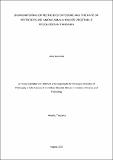| dc.description.abstract | This study assessed drivers of increased and changing patterns of pesticide use, levels of
Acetylcholinesterase (AChE) inhibition, associated health effects and co-exposure risks of
pesticide residues and bacterial contaminants in fresh vegetables. A total of 613 vegetable
samples were collected from Arusha, Kilimanjaro, Manyara, Dar es Salaam, Morogoro and
Iringa, regions. Binary probit models were used to analyze factors fostering increased
pesticide use, determinants of pesticide exposure and risks of co-exposure. Significant results
were accepted at p < 0.05. Results revealed that most farmers (88.9%) were unaware of
pesticide safety practices. Compared with previous studies, there was increased trend in
pesticide use (58.4%), which was accompanied by changing pesticide formulations. The
number of crops grown (p = 0.002), pesticide mixing (p = 0.012) and region (p = 0.001)
contributed positively to likelihood for increased pesticide use. Smallholder farmers were
found to be occupationally exposed to pesticides, where exposed farmers had significantly
lower AChE levels. The number of exposure symptoms (14.10±7.70) was higher in exposed
than unexposed farmers. Self-reported symptoms were also confirmed to correlate with lower
AChE and the use of personal protective equipment did not significantly reduce exposure.
Women, younger and older farmers, underweight, overweight, and obese farmers were at
increased risk of pesticide exposure. Moreover, locally produced fresh vegetables were
highly contaminated with pesticide residues, 47.5% had detectable levels of pesticide
residues, 74.2% of which recorded average residue levels above Codex Maximum Residue
Levels (MRL) standards. Multiple pesticide residues were also detected, these included
organophosphates (95.2%), organochlorines (24.0%), pyrethroids (17.3%) and carbamates
(9.2%), all constituting the main detected pesticide residues. Consequently, bacterial
contamination of fresh vegetables was also evident, with prevalence of bacterial
contamination being high (63.2%). Enterobacter (55.6%), Pseudomonas aeruginosa (32.4%),
E. coli (28.2%), Citrobacter (26.8%), Klebsiella oxytoca (14.8%) and Salmonella (7.7%)
were isolated. 46.4% of tested samples were positive for both pesticide residues and bacterial
contaminants. Vegetables from farms (60.7%) contained more bacterial contaminants while
vegetables with pesticide residues were about twice more likely to be contaminated with
bacteria (OR: 2.231; 95% CI: 0.501, 8.802). Findings from this study also showed extensive
use of pesticides, bacterial contamination and exposure among small holder farmers. The
observed exposure risks pose short and long-term effects on health of both farmers and
general population. The contamination levels of pesticide residues and bacterial contaminants
could also be perceived as a serious health problem, as most fresh and vegetables recorded
values of pesticide residues far above the Maximum Residue Limits (MRLs) with pathogenic
bacteria isolated in higher proportions. Maximum Residue Limits were higher in most
vegetables that were consumed raw or semi-cooked. There is therefore an urgent need to
develop pesticide monitoring and surveillance systems at farmers’ level by educating farmers
and promoting the use of greener pesticides to mitigate the health effects of pesticides and
bacterial contaminants. | en_US |

